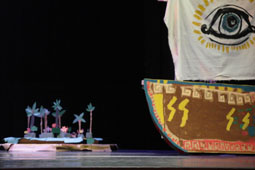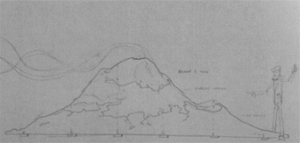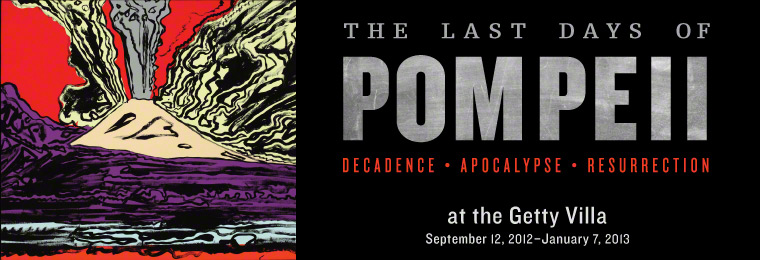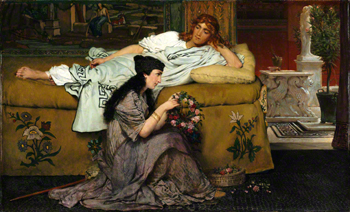Free admission tickets is easiest by phone and you will receive an admission code for all the people in your vehicle. Enjoy the creative theatre, music and art available on this special day. Plan your day with the detailed program is below.
 | |
Family Festival Celebrating
The Last Days of Pompeii
Date: Sunday, December 2, 2012
Time: 10:00 a.m.–5:00 p.m.
Admission: Free; reservations required. Call (310) 440-7300 or use the "Get Tickets" button below.
Time: 10:00 a.m.–5:00 p.m.
Admission: Free; reservations required. Call (310) 440-7300 or use the "Get Tickets" button below.
Grab the kids and run! . . .
. . . to this daylong festival exploring the role of Pompeii in the popular cultural imagination through crafting, performances, and other family-friendly adventures. Pose for a family portrait in front of Mount Vesuvius. Appear in an art-inspired theatrical spectacle. Or create a flow of volcanic lava to wear on your head!
 | |
OUTDOOR THEATER
Vesuvius Explodes! by Kiel Johnson
10:00 a.m.–5:00 p.m.
Artist Kiel Johnson sculpted a massive model (standing 8' tall and 18' wide) of Mount Vesuvius at the moment of eruption—billowing smoke and all!
Fleeing Pompeii — A Captured Moment with Snap Yourself
11:00 a.m.–5:00 p.m.
Become a part of the pictorial tradition of fleeing Vesuvius! Strike a pose with your loved ones, inspired by the paintings on view in Floor 2 of the Museum's galleries. The professional photographers of Snap Yourself will create a unique family portrait "in flight," shot before the panoramic landscape of the smoldering volcano.
EDUCATION COURT
Design a PyroDrama!
First session: 10:00 a.m.–noon
Second session: 1:00 p.m.–3:00 p.m.
Become a theatrical designer and create set pieces for the PyroDrama performances in the Auditorium later in the day (see below). You can also construct Pompeian stage props, see them used by actors onstage, and finally bring them home as souvenirs after the show.
OUTER PERISTYLE
Vesuvius Cone Heads: Kapow Wow! — with Marni Gittleman
10:00 a.m.–5:00 p.m. (last seating at 4:30 p.m.)
Construct a volcanic cone to wear home on your head. Let your imagination erupt with ideas as you craft cascading bits of red-hot lava!
Flaming Frames
10:00 a.m.–5:00 p.m. (last seating at 4:30 p.m.)
Craft the perfect frame for the photo you'll create at "Fleeing Pompeii." Decorate your creation with lava and flames to "frame your escape" from Vesuvius.
INNER PERISTYLE
Music Inspired by The Last Days of Pompeii — with dublab
10:00 a.m.–5:00 p.m.
The dublab DJs spin musical sets inspired by the three themes of the exhibition: decadence, apocalypse, and resurrection. These curated sets reflect Pompeii and its influence on popular culture and the world psyche.
Beats by You — with dublab
1:00–1:20 p.m. - Decadence
2:00–2:20 p.m. - Apocalypse
3:00–3:20 p.m. - Resurrection
Work with the DJs of dublab to make your own sounds and add them to the mix.
AUDITORIUM
Pyrodrama – Theater Workshop and Performance with Sam Robinson
First workshop: Noon–1:00 p.m.
First rehearsal and performance: 1–1:30 p.m.
Second workshop: 3:00 p.m.–4:00 p.m.
Second rehearsal and performance: 4:00–4:30 p.m.
In a one-hour workshop session, kids learn the power of creative communication through theater techniques such as gesture, facial expression, and body position. In the optional rehearsal session that follows, kids then work with professional actors to create living stage pictures (once called tableaux vivants), inspired by art in the Pompeii exhibition. Rehearsal then culminates in a performance spectacle on the Auditorium stage: The Last Days of Pompeii!!
Vesuvius Explodes! by Kiel Johnson
10:00 a.m.–5:00 p.m.
Artist Kiel Johnson sculpted a massive model (standing 8' tall and 18' wide) of Mount Vesuvius at the moment of eruption—billowing smoke and all!
Fleeing Pompeii — A Captured Moment with Snap Yourself
11:00 a.m.–5:00 p.m.
Become a part of the pictorial tradition of fleeing Vesuvius! Strike a pose with your loved ones, inspired by the paintings on view in Floor 2 of the Museum's galleries. The professional photographers of Snap Yourself will create a unique family portrait "in flight," shot before the panoramic landscape of the smoldering volcano.
EDUCATION COURT
Design a PyroDrama!
First session: 10:00 a.m.–noon
Second session: 1:00 p.m.–3:00 p.m.
Become a theatrical designer and create set pieces for the PyroDrama performances in the Auditorium later in the day (see below). You can also construct Pompeian stage props, see them used by actors onstage, and finally bring them home as souvenirs after the show.
OUTER PERISTYLE
Vesuvius Cone Heads: Kapow Wow! — with Marni Gittleman
10:00 a.m.–5:00 p.m. (last seating at 4:30 p.m.)
Construct a volcanic cone to wear home on your head. Let your imagination erupt with ideas as you craft cascading bits of red-hot lava!
Flaming Frames
10:00 a.m.–5:00 p.m. (last seating at 4:30 p.m.)
Craft the perfect frame for the photo you'll create at "Fleeing Pompeii." Decorate your creation with lava and flames to "frame your escape" from Vesuvius.
INNER PERISTYLE
Music Inspired by The Last Days of Pompeii — with dublab
10:00 a.m.–5:00 p.m.
The dublab DJs spin musical sets inspired by the three themes of the exhibition: decadence, apocalypse, and resurrection. These curated sets reflect Pompeii and its influence on popular culture and the world psyche.
Beats by You — with dublab
1:00–1:20 p.m. - Decadence
2:00–2:20 p.m. - Apocalypse
3:00–3:20 p.m. - Resurrection
Work with the DJs of dublab to make your own sounds and add them to the mix.
AUDITORIUM
Pyrodrama – Theater Workshop and Performance with Sam Robinson
First workshop: Noon–1:00 p.m.
First rehearsal and performance: 1–1:30 p.m.
Second workshop: 3:00 p.m.–4:00 p.m.
Second rehearsal and performance: 4:00–4:30 p.m.
In a one-hour workshop session, kids learn the power of creative communication through theater techniques such as gesture, facial expression, and body position. In the optional rehearsal session that follows, kids then work with professional actors to create living stage pictures (once called tableaux vivants), inspired by art in the Pompeii exhibition. Rehearsal then culminates in a performance spectacle on the Auditorium stage: The Last Days of Pompeii!!






